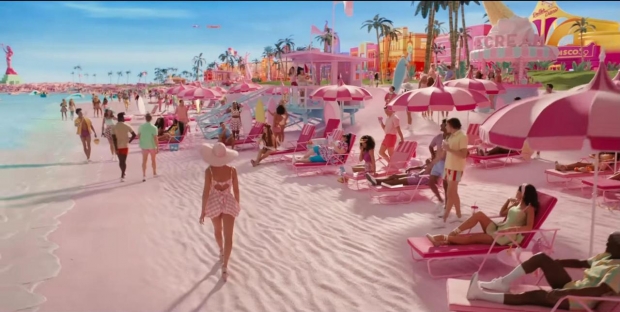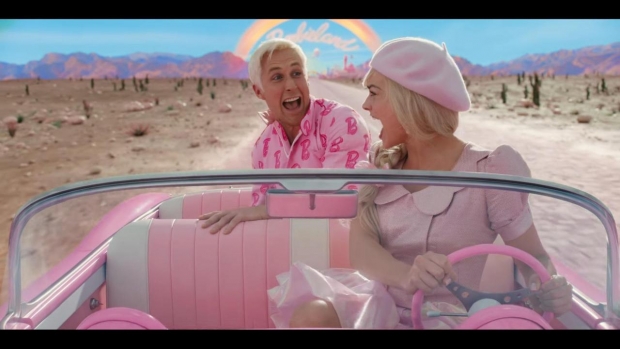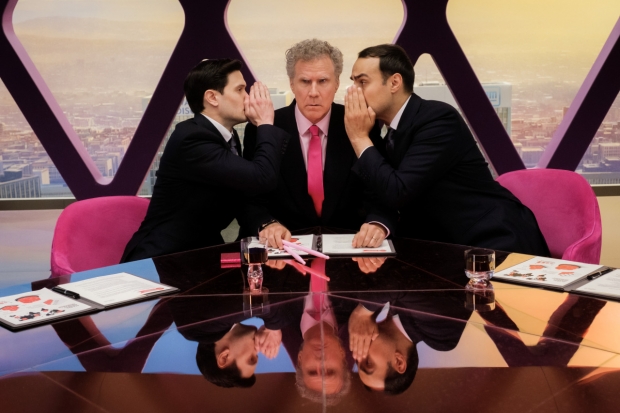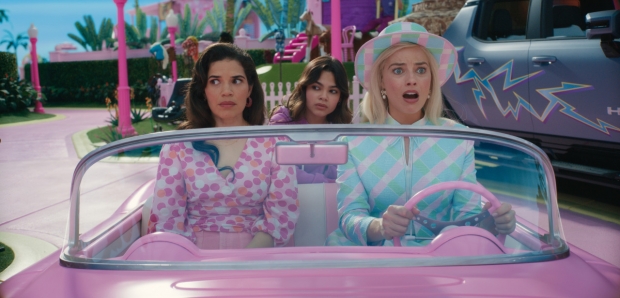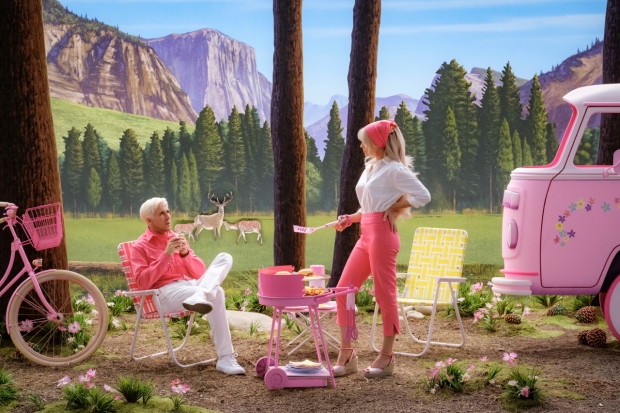The VFX supervisor on Greta Gerwig’s hit film sheds light on the various ways the famed Mattel doll and her world came to life across 1,300 shots involving various digital filmmaking tools, including virtual production, previs, postvis, CG set augmentation, and more than 20 fully CG shots, produced by Framestore, Chicken Bone FX, FuseFX, UPP, and Lola VFX.
Much has been made of Barbie and Oppenheimer sharing the same theatrical release date to the point that clever fan posters were created to promote a possible double bill coined Barbenheimer. Both productions also notably shared the declaration that they contained no visual effects when in fact, the famed physicist’s biopic, directed by Christopher Nolan, utilized digital compositing; and there are full CG shots as well as CG augmentation used to bring the adventures of a Mattel doll to life by Greta Gerwig.
Caught the middle of the controversy are Glen Pratt and Andrew Jackson, the visual effects supervisors responsible for the two projects. Their presence on the credit list highlights the ludicrous nature of the public statements. What remains to be seen is whether the studios and filmmakers will flip the denial script for the award campaign season as Barbenheimer is expected to be a dominate force.
“The Internet has a lot to answer for [when it comes to Barbenheimer],” laughs Pratt, VFX Supervisor on Barbie. “There was a really good poster created by an amateur artist made in the classic early 1980s late 1970s film poster language.” Life did imitate art when Mattel executives met with Gerwig and the film’s producers during pre-production to voice concerns about how the iconic toy was being portrayed, ultimately echoed in scenes starring Will Farrell as the Mattel CEO. According to Pratt, “When Greta spoke about it, she told them, ‘Either I make the film I want to make or you can make another film. But that’s the film I want to make.’ And she got to make it, which was great.”
Photorealism is a standard goal for live-action visual effects; however, Pratt had to deal with the extra twist of Barbie Land being highly stylized. “As long as you have a good reference point of what you’ve got to match to, visual effects can always achieve that,” he explains. “I remember doing development work on the digital aspects of the film, which there was quite a lot even though certain people are saying that there’s no CG. In one way, it goes against what visual effects artists are used to working with, which is you have to create something that matches closely to reality. But this reality was Barbie Land which has a heightened design aesthetic.”
Making a dramatic genre shift was cinematographer Rodrigo Prieto, who had lensed true life murder conspiracy Killers of the Flower Moon for Martin Scorsese before joining the satirical fantasy starring Margot Robbie and Ryan Gosling. “Rodrigo was brilliant and so was Greta,” Pratt says. “She was an absolute joy to work with and that was infectious. Rodrigo had his work cut out. When filming, he had swathes of grey cloth under the camera and on the surrounding floor to neutralize the spill coming from the pinks, blues, bright greens and yellows of the sets; that allowed him to balance the faces and light Margot so she didn’t look green or bright pink. It was interesting to see the other side of a lot of the shots.”
Miniatures were constructed for key sections of Barbie Land at the behest of Gerwig, which, Pratt notes, “allowed visual effects to scan and capture them with photogrammetry.” He adds, “Upon that we were able to build them as 3D assets that could be dressed into set and shots as need be. That was planned to give visual effects an understanding of the visual language. Sometimes we were making entirely CG shots and it was always trying to retain the feeling of being miniature and toy-like.”
“Even if you look at the sets that were physically built like the Barbie Dream House,” Pratt continues. “We shot clean plates of that for certain shots and in those clean plates, when you looked at them without any actors or crew in them, it looked like a toy. We were taking that and extrapolating further upon that language.”
There are over 20 fully CG shots in the film. “In the Dawn of Women sequence, which is Greta’s version of 2001: A Space Odyssey there is an entirely CG shot of the original Barbie doll, which doubles as the monolith,” Pratt reveals. Framestore did concept art, visual development, previs, postvis, and virtual production, totalling 700 shots, while Chicken Bone FX, FuseFX, UPP, and Lola VFX contributed 300 shots. 600 of the 1,300 shots required extensive visual effects work. “When Barbie is first driving out onto the open road environment and you have the big Barbie Land rainbow, all of that was essentially bluescreen,” Pratt shares. “There was a tiny bit of set and pink road but the car had to be moving. The sky, distant vista of Barbie Land and the mountains were created digitally from reference photography of the sets that were built. We created an entirely CG environment.”
Some visual effects shots are found in the real-world portion of the story. “It was relatively more contained and from an aesthetic point of view it wasn’t as much of a puzzle,’ states Pratt. “The car with Mattel security men that Barbie, Sasha [Ariana Greenblatt], and Gloria [America Ferrera] are driving away from was entirely CG. The interiors were shot back at Warner Bros. Studios Leavesden with a volume projection. We shot driving plates that were projected so there was the right lighting on the car and we reinserted the moving backgrounds in post.”
Virtual production proved a useful tool with the LED screen content being replaced in post-production. Describing an early version of what the buildings in Barbie Land would look like, Pratt says, “Because of scheduling we couldn’t get the finished results from the art department into the volume but it gave us a good enough building block for Rodrigo and Greta, who were keen to use that knowledge as it provided us with a more complex lighting, particularly for the driving shots of Barbie in Barbie Land. We were adding digital doubles and buildings right up until the first shot where Barbie steps onto the beach and starts to wave.”
The beach scenes were primarily bluescreen, though virtual production tools were utilized to help people understand certain shots that involved complex camera moves. “Some of those shots we actually did virtually scout beforehand with Greta and Rodrigo as well as for the open road,” reveals Pratt. “We also did virtual scouting for ‘I’m Just Ken’ and the battle on the beach to get the size of shots right as Greta always wanted it to feel like a heightened Oculus version of Gladiator. Floatable things are being thrown around like projectiles and we had to extend the crowd into the length of the beach. It’s a nod to Gladiator, Dunkirk and Saving Private Ryan.” Gerwig describe the aesthetic as being “authentic artificiality.” “That phrase sums up when you’re in Barbie Land,” Pratt says. “It was making sure we kept that in our mind’s eye all the way through. At one point the artists at Framestore were using too much of their experience of making it look real but sometimes you had to dial that back or push it further to get the right result. A lot of those cues were already in the photography. In one sense it was always checking ourselves that this was the correct aesthetic we were getting across but that’s always the way with films.”
Pratt was impressed with how Gerwig approaches filmmaking. “Greta used the tools and crafts that she had at her disposal so well and was mindful that she had people who knew what they were doing so she would be trusting and asking them their opinion as to what they felt was a good choice,” remarks Pratt. “I was with Greta all the way through post-production while the movie was being cut so I could be a conduit for her to the vendors making sure what she wanted was achieved. I was waiting for a lot of notes and I didn’t get many.” Pratt felt no skepticism about joining the project. “To be honest, when I got asked to do Barbie, I was excited,” he reveals. “Greta is a unique filmmaker and to engage with her is a hugely creative process. It’s an evolution of discussions and talking. You try stuff and show it. As like most films it always evolves from when you start to shooting to post-production. But there were some clear ideas Greta had from the beginning that absolutely stayed, like Barbie Land appearing as a toy miniature world, and nods to popular musicals and Emeric Pressburger films such as The Red Shoes. I loved the whole experience.”



